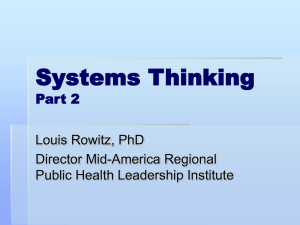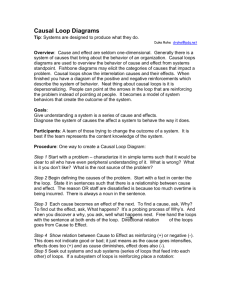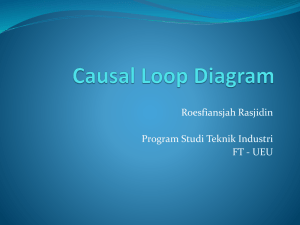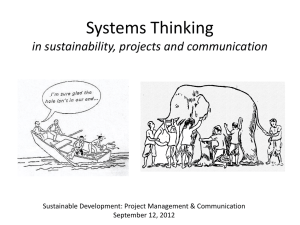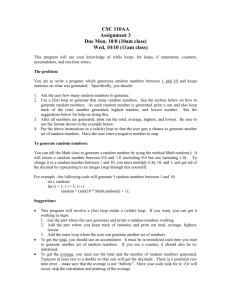Test Drives - Systems Thinking World
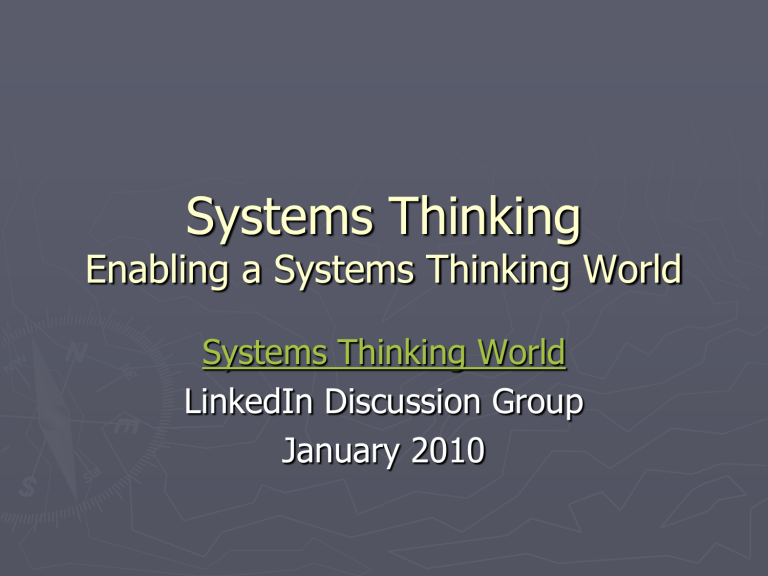
Systems Thinking
Enabling a Systems Thinking World
Systems Thinking World
LinkedIn Discussion Group
January 2010
Systems Thinking
►
A way of viewing the world, which
►
Realizes the realities of a system, which is
An entity that maintains it existence through the mutual interaction of its parts, and requires
►
Anasysthesis, an integration of analysis and synthesis, and demands
►
Seeing and acting in a manner which considers the trees, the forest, the intentioned actions, and their implications
Thoroughly Confused Yet?
►
Now we shall simplify
►
A System
A influences B
B influences A
Mutual interaction
A B
►
If you change A you change B, and if you change B you change A
►
This is as simple as it gets!
Do You Need Systems Thinking?
►
►
►
►
►
►
►
There are multiple perspectives on just what the situation is, and how to deal with it
Things seem to oscillate endlessly
A previously applied fix seems to overshoot the goal
A previously applied fix has created problems elsewhere
Over time there is a tendency to settle for less
After a fix is applied, in time the problem returns
The same fix is used repeatedly
►
►
►
►
►
►
►
There is a tendency to allow an established standard to slip
Growth slows over time
Partners for growth become adversaries
Limitations experienced are believed to result from insufficient capacity
There is more than one limit to growth
Limited resources are shared by others
Growth leads to decline elsewhere
Implications of Systems
►
►
►
►
►
►
Today’s problems come from yesterday’s “solutions.”
The harder you push, the harder the system pushes back.
Behavior grows better before it grows worse.
The easy way out usually leads back in.
The cure can be worse than the disease.
Faster is slower.
►
►
►
►
►
Cause and effect are not closely related in time and space.
Small changes can produce big results—but the areas of highest leverage are often the least obvious.
You can have your cake and eat it too—but not all at once.
Dividing an elephant in half does not produce two small elephants.
There is no blame.
Implications of Systems (2)
►
►
Cause and effect are separate in time and space. Consequently, system changes often have unintended consequences which are seldom connected to their cause
The structure of a system determines its behaviour
In a system with no causal chains (no feedback) the output is determined (and usually proportional to) the inputs.
In a system with feedback loops the output is determined by the
(dynamic) structure.
►
Most systems have multiple aims.
Changing any of these aims will change the system.
Optimization of systems cannot be achieved by maximizing performance of the parts in isolation.
Some components may need to be subordinated for the benefit of the whole.
Achieving this will require trust and cooperation: a willingness to
‘see the bigger picture
Diagnosis v Analysis
Quote from Russell Ackoff, Re-creating the Corporation
Levels of Awareness
►
Cause and effect (Simple)
►
Patterns of behavior responsible for cause and effect
►
Underlying structure responsible for the patterns of behavior
►
Cause and effect (multiple)
►
Underlying structures responsible for the patterns of behaviors
Levels of Awareness (2)
►
Which system – the problem or the potential solutions
►
What’s included /excluded (boundaries)
►
What is the best representation
►
How do know we have reached the end
(terminal end of our model more modelling is inconclusive)
Causal Loop Diagrams
►
An approach to understanding a system, though only qualitatively thing 1 adds to thing 2 thing 1 subtracts from thing 2 sales adds to revenue product sales subtracts from finished goods inventory resources interact with productivity to add to finished goods inventory
Reinforcing Loop
►
Action adds to a result which influences more of the same action in the future -> growth
Interest rate and principal interact to create interest
Interest adds to principal
Principal adds to interest
Balancing Loop
►
Attempts to bring two things into agreement. Goal seeking.
Desired state and current state interact to create a gap
Gap adds to action
Action adds to current state
Current state subtracts from gap
When current state reaches desired state gap = 0 and there’s not more impetus for action.
Which Loop is Which
►
Just count the minus “-” signs around the loop
An even number and it’s a reinforcing loop
An odd number and it’s a balancing loop
Delay
►
The implications of interaction often take time
►
Seldom does anything happen instantaneously
►
Systems deceive us because of delays
Emergent Characteristics
►
Systems exhibit characteristics which are not characteristics of any of their parts
►
Balancing Loop exhibits balance or goal seeking, not a property of any of its parts
►
Reinforcing Loop exhibits growth, not a property of any of its parts
Systems Archetypes
►
Combinations of balancing and reinforcing loops
►
Demonstrate very characteristic patterns of behavior
►
Occur frequently across all disciplines
Stock & Flow Diagrams
►
Within systems there are things which flow and things which accumulate
►
Neither of these things are explicitly represented in a Causal Loop Diagram
►
Stock & Flow diagrams enable one to think in more detail about the interactions of a system
Four Stock & Flow Primitives
►
Stock: represents a quantify of something.
Consider a bathtub containing water
►
Flow: represents the movement of something into or out of a stock. With the bathtub stock above, water can flow in or out
►
Parameter: represents a value involved in defining some part of an interaction
►
Link: conveys information about one primitive to another
Stock & Flow Interactions
►
Stocks increase or decrease only though a flow
►
Cloud indicates source or destination isn’t relevant for current consideration
Valid Interactions
► from a stock to a parameter,
► from a parameter to a parameter,
► from a parameter to a flow,
► from a flow to a parameter,
► from a parameter to a stock in order to establish its initial value.
Sample Interaction
►
Orders are a flow into inventory, a stock, causing it to increase. Sales, a flow, moves finished goods, a stock, out of the company.
►
Resources and productivity, parameters, interact in some manner to define production, a flow, that moves inventory to finished goods.
A Word of Caution
►
Causal Loop Diagrams and Stock & Flow
Diagrams are only qualitative representations of a system
►
Our ability to infer the implications of interactions is limited
►
A quantitative view of a system requires simulation of the stock and flow model
Limited Ability to Infer
►
►
►
►
High profile consulting company with 120 employees.
60 are professionals
60 are rookies in training to be professionals.
Clients billed
$15k per month for professionals
$5k per month for rookies
Takes 6 months for a rookie to become a professional
Company wants to remain at 120 employees
10 professionals quit each month
Rookie hired for each professional that quits
Company has $1.2 million in revenue per month
Structure and Steady State
Consider the Following
►
What will happen if the pro quit rate jumps from 10 to 12 in month 4
►
Try to chart the result without looking at the next slide
►
Very few are able to infer the implications of this change correctly
►
Systems are complex
The Implications
►
The one time change sets off a 6 month transition in the system where the number of pros declines from 60 to 48 and the number of Rookies increases from 60 to 72. While this transition is in progress revenue drops accordingly from $1.2 M per month to $1.08 M/month
It’s Just a Model
►
Models are simplifications of reality intended to promote understanding
►
Whether it is a good model or not depends on the extent to which it promotes understanding
*** REMEMBER ***
All models are false
Some models are useful
Levels of Understanding
►
►
►
►
Systemic Ignorance – where most of the world operates most of the time, yet the unrealized systems are having their affect all the time.
Causal Loops – while only qualitative, investigating a situation with causal loops provides one with a somewhat better chance of a sound decision than Systemic Ignorance.
Stock & Flow – while still only qualitative investigating a situation with a stock & flow diagram forces one to be more explicit regarding what flows and what accumulates and it is often found to be quite an improvement over simply employing Causal Loops.
Modeling & Simulation – simulating stock & flow diagrams with calibration, sensitivity testing, and related steps provides a quantitative awareness which enables the soundest perspective from which to make decisions.
Systems Thinking is Easy
►
Systems Thinking is essentialy the science of “AND”.
►
For every change, which may be an action or a result simply ask
What will this change influence, and
What will influence this change
►
And after you answer the question ask it again and again and again
Systems Exist
►
Systems exist and operate all the time
►
There is no escape
►
You can choose to understand them
►
Or by default chosen to be the victim of them
►
Do you have a preference?
►
Is it a difficult choice?
Why Become A Systems
Thinker?
Systems Thinking has the potential to provide you with a greater understanding of the world around you and more control over your life than any other subject you could possibly study!
Come Join Us
Systems Thinking World
Discussion Group on LinkedIn
&
FREE Systems Thinking Courses
SystemsWiki.org
